|
|
|
Sort Order |
|
|
|
Items / Page
|
|
|
|
|
|
|
| Srl | Item |
| 1 |
ID:
132490
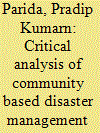

|
|
|
|
|
| Publication |
2014.
|
| Summary/Abstract |
Disaster may be de?ned as those extreme events either natural or man-induced, which exceed the tolerable magnitude within or beyond certain time limits, make adjustment dif?cult, result in catastrophic losses of property, income and lives and livelihood of people in general. Natural hazards involve comparatively high density processes and extreme events caused by both terrestrial and atmospheric processes. Where the impact of hazard is such that normal community and organizational arrangements are no longer functioning, disaster can be said to have occurred. Natural disasters take a huge toll of human lives and property and severely hamper development. It may not be possible to prevent natural disasters totally, but with careful pre-disaster planning and preparedness, we can reduce the adverse effect of the hazards and the economic loss. Here is required the signi?cance of disaster management.
|
|
|
|
|
|
|
|
|
|
|
|
|
|
|
|
| 2 |
ID:
132495
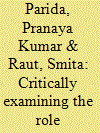

|
|
|
|
|
| Publication |
2014.
|
| Summary/Abstract |
Each day, natural disasters such as ?oods, earthquakes and hurricanes/ cyclones threaten human life and cause severe environmental losses around the world. During the last decade, disasters have affected the lives and assets of almost 2.4 billion people across the world (OCHO, 2010). In India alone since the year 2000, an average 65 million people have been affected by disasters every year. Of this, 8.45 million have been children under the age of ?ve and 3.25 million are pregnant and lactating mothers (UNICEF). Such
humanitarian crises often set back the developmental gains of lesser developed regions by several" decades. Not only do disasters lead to the loss of life and property, but "the immediate a?ermath is a complex situation complicated by issues of logistics, search and rescue, relief distribution, limited accessibility to some of the affected areas, the threat of secondary disasters, the mostly well-intentioned interests of diverse stakeholder groups (which many a times are external to the context of thedisaster), the in?ow of aid material and grants, political interest, media interest and often limited administration capacity. Government is responsible for administrative arrangements dealing with disasters.- Effective policies play a vital role in mitigating the impact of disasters and reducing likely losses of life and property ( Erramilli, 2008) . The disaster management, which is not being treated as a sector by itself, is
undergoing major changes, especially at the institutional and policy levels, which are prompted by various. macro-level factors ( Wagle and Warghade, 2006). Effective coordination among various stakeholders, specifically the Government, the international community and nongovernmental organizations (NGOS) in the aftermath of a disaster is critical to, among other things, a minimization in disaster response time, the proper allocation of resources and the avoidance of duplication of response efforts; Moreover, as economic growth and sustainable development are essential to successful disaster preparedness and mitigation efforts, effective coordination has the potential to strengthen the link between emergency response, preparedness and long-term development strategies.
|
|
|
|
|
|
|
|
|
|
|
|
|
|
|
|
| 3 |
ID:
132489
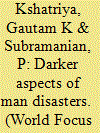

|
|
|
|
|
| Publication |
2014.
|
| Summary/Abstract |
Disaster is a term one would rather be not associated with because of the negative vibes that it sends out. The ways and means to overcome the negative-thoughts that are brought on in the wake of disaster assume a lot of importance. The consequences of disaster have such far reaching and destructive effects that we become helpless individuals running helter skelter to seek protection and also recover from the shock of disaster.
|
|
|
|
|
|
|
|
|
|
|
|
|
|
|
|
| 4 |
ID:
132497
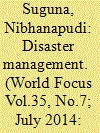

|
|
|
|
|
| Publication |
2014.
|
| Summary/Abstract |
Hundreds of Natural disasters take place worldwide every year causing irreparable damage to life and property. Earthquakes, ?oods, typhoons, hurricanes,- Tsunamis are among the worst of these natural disasters. Over the last few decades, there has been an alarming increase in the occurrence of natural disasters and the magnitude of their social, economic and environmental impact. During any natural disaster it is usually the" children who suffer the most. The nation witnessed the death of nearly a thousand children during the 2001 Bhuj earthquake. Out of them, 300 died while marching for the Republic day parade. They were in a narrow lane when the earthquake hit causing buildings onboth sides to collapse. It is said thatpnearly 1,884 school buildings collapsed leading to a loss of 5,950 class rooms. About 12000 schools suffered damages making them un?t for children to continue their studies. Fire tragedies, like the one in Kurnbakonam killed 93 children in a school. Another ?re accident in Dabwali, Haryana where a ?re broke out during a schoolfunction took he lives of many school children. Children in schools are the 'most vulnerable group during any disaster. These tragedies reiterate the need for all of us to sit up and think about the safety of these children. It is necessary to make schools safe and hazard proof. For this purpose, it is important to have disaster management, emergency preparedness and response plans at school level.
|
|
|
|
|
|
|
|
|
|
|
|
|
|
|
|
| 5 |
ID:
132494
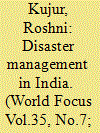

|
|
|
|
|
| Publication |
2014.
|
| Summary/Abstract |
Development and welfare of human beings is intimately related to the natural environment. Normally, environment is a source of livelihood but at times due to the intensive intervene made by human it brings
hazards like earthquake, cyclone, ?ood, landslide etc. further these hazards turns into disasters causing losses of life and property.' These hazards can be minimized by using modern scientific and technological
advancements. Disaster is a sudden adverse or unfortunate extreme event which causes great damage to human beings as well as plants and animals. Disasters I occur rapidly, instantaneously and indiscriminately which wipe out the years of development in a matter of hours. Disaster may be natural or man-made chaos and destruction reigns everywhere. It doesn't only justify initial death and damage occurrence but even the post-disaster tranquility and sufferings that too without any doubt regenerate pain and misery. Around 76% of India's coastline is prone to cyclones and tsunamis, while 59% of the country is vulnerable to earthquakes, 10% to-?oods and river erosion, and 68 %_to droughts? This has been stated by National Policy on Disaster Management that, "Disaster disruptsprogress and destroys the hard earned fruits of painstaking developmental efforts, often pushing nations, in to the quest for progress, back by several decades. Thus ef?cient management of disasters rather than mere response to their occurrence has in recent days received increased attention both in -India and abroad. This is as much a result of the recognition of the increasing frequency and intensity of disasters as it is an acknowledgement that good governance, in a caring and civilized society, needs to deal effectively with the devastating impact of disasters?"
|
|
|
|
|
|
|
|
|
|
|
|
|
|
|
|
| 6 |
ID:
132498
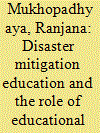

|
|
|
|
|
| Publication |
2014.
|
| Summary/Abstract |
Disasters are increasing exponentially. The number of disaster events which was 73 in 1900-09 has increased to 4494 during 2000-09. More people were affected in the two recent decades than the earlier ones. During the second half of the 20th century, more than 200 major natural disasters occurred in different parts of the world and claimed the lives of around 1.4 million people. In 2011 alone, 302 hazards resulted in disasters that claimed almost 30,000 lives, affected 206 million people and in?icted damages worth an estimated USS 366 billion, according to the United Nations Office for Disaster Risk Reduction.
|
|
|
|
|
|
|
|
|
|
|
|
|
|
|
|
| 7 |
ID:
132499
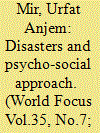

|
|
|
|
|
| Publication |
2014.
|
| Summary/Abstract |
Disasters both manmade as well as natural often result in great physical and material loss for the affected communities, besides affecting the social, physical and psychological well-being of the survivors in its aftermath. It has been seen that disasters have an adverse impact on the survival, dignity and livelihoods of individuals and communities, particularly of the poor, in both developed and less developed countries. There are multiple factors which have been attributed as causes of these extreme events, like environmentally unsound practices, global climatic changes, population growth, urbanization, social injustice, poverty etc. However, when it comes to comprehension of disasters in contemporary times, there is a need to look at disaster as social phenomena. This is precisely, with regard to man- nature relationship discourse. While explaining this relationship, Kroeber (1939 p1), rightly writes, ' while it is true that cultures are rooted in nature, and can therefore never be understood except with reference to that piece of nature in which they occur, they are no more produced by that nature thana plant" is produced or caused by the soil in which it is rooted. The immediate causes of cultural phenomena are other cultural phenomena.
|
|
|
|
|
|
|
|
|
|
|
|
|
|
|
|
| 8 |
ID:
132493
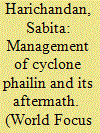

|
|
|
|
|
| Publication |
2014.
|
| Summary/Abstract |
Phailin, a tropical cyclone with wind speed of 220 kmph hit Odisha coast on 12 October 20l3,leaving
a trail of destruction. Tropical cyclone is a storm system characterized by a low pressure centre which produces a.strong wind and ?ooding rain. Tropical cyclones are named to provide easy communication between forecasters and the public. Phailin represented the second-stronger tropical cyclone after 1999 Super Cyclone. There is no gainsaying the fact that Odisha with a coastline of 4801-cm is prone to natural disasters like tropical cyclones, storm surge, whirl wind, tsunami and rain-induced ?oods on account of its sub-tropical littoral location. The 480 Km. long coastline of Odisha extends from Balasore in the North to Ganjam Coast in the South. These natural hazards cause immense damage to life and property. According to reports of Indian Meteorological Department (IMD), total number of cyclonic storms and severe cyclonic storms crossing Odisha coast between 1891 to 2000 was 98 while 69, 79 and 62 cyclones struck the coasts of West Bengal, Andhra Pradesh and Tamil Nadu respectively. Super Cyclone of 1999 devastated 14 districts of Odisha with 'catastrophic human consequences.
|
|
|
|
|
|
|
|
|
|
|
|
|
|
|
|
| 9 |
ID:
132492
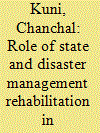

|
|
|
|
|
| Publication |
2014.
|
| Summary/Abstract |
Disaster Management is the discipline of dealing with and avoiding risks. It is a discipline that involves preparing for disaster before it occurs, disaster response (e.g. emergency evacuation, quarantine, mass decontamination, etc.), as well as supporting, and rebuilding society after natural or human-made disasters have occurred. In general, any disaster management is the continuous process by which all individuals, groups, and communities manage hazards in an effort to avoid or ameliorate the impact of disasters resulting from the hazard. Disaster and emergencies appears to be as inevitable as taxes; so too is our on-going effort to cope with them. The ability to cope lies" deep in our primordial past, which has taught us that "organising" is the most efficient and effective means to survive. Sometime due to major accident and leakage the situation become worst for the nearby peoples.
|
|
|
|
|
|
|
|
|
|
|
|
|
|
|
|
|
|
|
|
|